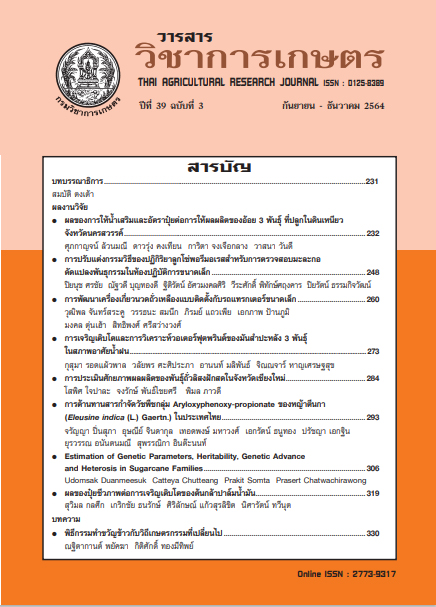การปรับแต่งกรรมวิธีของปฏิกิริยาลูกโซ่พอรีมอเรสสหรับการตรวจสอบมะละกอดัดแปลง พันธุกรรมในห้องปฏิบัติการขนาดเล็ก
DOI:
https://doi.org/10.14456/thaidoa-agres.2021.20คำสำคัญ:
มะละกอดัดแปลงพันธุกรรม, เทคนิคพีซีอาร์, การตรวจคัดกรองยีนบทคัดย่อ
จากมาตรการห้ามนำเข้าพืชดัดแปลง พันธุกรรมในหลายประเทศ ผู้ประกอบการส่งออก มะละกอของประเทศไทย มีความจำเป็นต้องตรวจ คัดกรองการปะปนของมะละกอดัดแปลงพันธุกรรม ตั้งแต่แปลงเกษตร การตรวจผลิตผลที่รับซื้อ และตรวจผลิตภัณฑ์ก่อนการส่งออกไปยังประเทศ อื่น ๆ ซึ่งปัจจุบันการตรวจคัดกรองพืชดัดแปลง พันธุกรรมนิยมใช้เทคนิค Real-time PCR ที่เป็น วิธีมาตรฐานระดับสากล แต่มีต้นทุนการตรวจ วิเคราะห์สูงงานวิจัยนี้มีวัตถุประสงค์เพื่อปรับแต่ง เทคนิค PCR ซึ่งเป็นเทคนิคพื้นฐานให้สามารถ นำมาใช้ตรวจวิเคราะห์การปะปนของมะละกอ ดัดแปลงพันธุกรรม ให้มีประสิทธิภาพเหมาะสม กับห้องปฏิบัติการขนาดเล็ก และมีต้นทุนการตรวจ วิเคราะห์ตำ ่ โดยศึกษาปัจจัยภายในที่เกี่ยวข้องกับ การทำปฏิกิริยาพีซีอาร์เพื่อใช้ในการตรวจสอบยีน 35SCaMV promoter Nos terminator ยีน nptII และยีน papain ได้แก่ ช่วงอุณหภูมิannealing ที่สามารถตรวจพร้อมกัน 3 ยีน ชุดไพรเมอร์ของ แต่ละยีน ความเข้มข้นสุดท้ายของไพรเมอร์ปริมาณ ดีเอ็นเอที่ใช้ และวิธีการสกัดดีเอ็นเอที่เหมาะสม ในการทำปฏิกิริยา PCR และดำเนินการศึกษา ปัจจัยภายนอกได้แก่ เครื่อง PCR โปรแกรมและ จำนวนรอบของการทำปฏิกิริยา PCR ผลการ ศึกษา พบว่า การตรวจคัดกรองยีนดังกล่าวด้วย เทคนิค PCR ต้องประกอบด้วยปัจจัยดังต่อไปนี้ 1) อุณหภูมิannealing ที่เหมาะสมสำหรับการ เพิ่มปริมาณทุก ๆ ยีน คือ 58๐ ซ. 2) ความเข้มข้น สุดท้ายของไพรเมอร์คือ 0.2 ไมโครโมลาร์และ 3) ปริมาณดีเอ็นเอเริ่มต้นที่เหมาะสม คือ50 นาโนกรัม ต่อปฏิกิริยา เป็นต้นไป โดยวิธีการสกัดดีเอ็นเอที่ ไม่เหมาะสมอาจหลงเหลือสารยับยั้งปฏิกิริยา ซึ่ง ส่งผลต่อผลผลิตปฏิกิริยา PCR นอกจากนี้การ ลดระยะเวลาในขั้นตอน Initial Denaturation และ Extension ลงขั้นตอนละ 5 นาทีรวมถึง การลดจำนวนรอบในการทำปฏิกิริยา PCR เป็น จำนวน 10 รอบ สามารถช่วยลดระยะเวลาการ ตรวจวิเคราะห์มะละกอดัดแปลงพันธุกรรมได้ 40 นาทีโดยให้ผลปฏิกิริยาที่มีประสิทธิภาพเทียบเท่า วิธีการวิเคราะห์ด้วยโปรแกรมดั้งเดิม ที่ใช้ระยะ เวลาประมาณ 2 ชม.
References
นุชนาถ วารินทร์, ศรีเมฆ ชาวโพงพาง, อัญจนา บุญชด, กนกวรรณ รมยานนท์, ราตรี รอดอารีย์, วิชัย โฆษิตรัตน, สุพัฒน์ อรรถธรรม. 2546. มะละกอพันธุ์ใหม่ต้านทานไวรัสใบด่างวงแหวนมะละกอ.หน้า.539-546. ใน: รายงานการประชุมวิชาการครั้งที่ 14. มหาวิทยาลัยเกษตรศาสตร์. กรุงเทพฯ.
ปิยนุช ศรชัย ธีระ ชูแก้ว ณัฐวดี บุญทองดี ฐิติรัตน์ อัศวมงคลศิริ และขนิษฐา วงศ์วัฒนารัตน์. 2562. การทดสอบความใช้ได้ของการตรวจจำแนกยีน Event specific Mon 810 และ NK603 และยีนอ้างอิงพืชด้วยเทคนิค multiplex real-time PCR. วารสารวิชาการเกษตร. 37 (3): 224-237.
Amersham Biosciences. 1998. PCR Product Analysis: a guide to using semidry flatbed gel electrophoresis. Amersham Biosciences Limited, USA, 52p.
Chris V., S. Agapito-Tenfen, and G. Abou-Sleymane. 2014. Overview of available detection methods, including validated methods in Summary of The activities under the electronic network of laboratories for the detection and identification of Living Modified Organisms (2012-2014).page 8-22. In: Conference of the parties to the convention on biological diversity serving as the meeting of the parties to the Cartagena protocol on Biosafety, 7th meeting Pyeongchang, Republic of Korea, 29 September-3 October 2014.
Debnath, M., Prasad G.B.K.S and Bisen P.S. 2010. Molecular Diagnostics: Promises and Possibilities Dordrech Heidelberg London, Springer, pp 129-152.
Hahn, M., J. Wilhelm and A. Pingoud. 2001. Influence of fluorophor dye labels on the migration behaviour of PCR amplified short tandem repeat during denaturing capillary electrophoresis. Electrophoresis. 22: 2691-2700.
Hwang Bo, K., S.H. Son, J.K. Lee, S.R. Min, S.M. Ko, J.R. Liu, D. Choi and W.J. Jeong. 2010. Rapid and Simple Method for DNA Extraction from Plant and Algal Species Suitable for PCR Amplification Using a Chelating Resin Chelex 100. Plant Biotechnol Rep. 4: 49-52.
Kasajima, I., Y. Ide, N. Ohkama-Ohtsu, H. Hayashi, T. Yoneyama and T. Fujiwara. 2004. A Protocol for Rapid DNA Extraction from Arabidopsis thaliana for PCR Analysis. Plant Mol. Biol. Reporter. 22: 49–52.
Kim, S.R., J. Yang, G. An and K.K. Jena. 2016. A Simple DNA Preparation Method for High Quality Polymerase Chain Reaction in Rice. Plant Breed Biotech. 4(1):99-106.
Mehmet, D., F. Ahmed, JM. Cummins, R. Martin and J. Whelan. 2001. Quantification of the common deletion in human testicular mitochondrial DNA by competitive PCR assay using a chimaeric competitor. Mol Human Rep. 7:301-306.
Peist, R., Honsel, D., Twieling, G., Löffert, D. 2001. PCR inhibitors in plant DNA preparations. QIAGEN News. 3:7–9.
Roger, S.O. and A.J. Bendich. 1985. Extraction of DNA from milligram amounts of fresh herbarium and mummified plant tissues. Plant Mol. Biol. 5: 69-76.
Walsh, P.S., Metzger D.A., and Higuchi, R. (1991). "Chelex 100 as a Medium for Simple Extraction of DNA for PCR-Based Typing from Forensic Material". BioTechniques. 10 (4): 506–513.
Van Pelt-Verkuil, E., Alex V.B. and Hays J.P. 2008. Principles and technical aspects of PCR amplification. Springer Science + Business Media B.V., Springer, 332 p.
Downloads
เผยแพร่แล้ว
How to Cite
ฉบับ
บท
License
Copyright (c) 2021 วารสารวิชาการเกษตร

This work is licensed under a Creative Commons Attribution-NonCommercial-NoDerivatives 4.0 International License.
วารสารวิชาการเกษตร


